I have been, or can be if you click on a link and make a purchase, compensated via a cash payment, gift, or something else of value for writing this post. As an Amazon Associate, I earn from qualifying purchases. Please read my full Affiliate Disclosure for more information.
Living in a small apartment can feel challenging when it comes to creating a cozy and stylish living room, but it’s also incredibly rewarding! Smaller spaces are popular because they encourage clever design solutions, maximize comfort, and make everyday living feel intimate and inviting.
In this article, you’ll find a variety of creative ideas to turn your small living room into a cozy haven. From smart storage tips to charming decor tricks, these ideas will help you make the most of your space while reflecting your personal style and creating a warm, welcoming atmosphere.
1. Use Soft, Layered Area Rugs to Define Cozy Zones
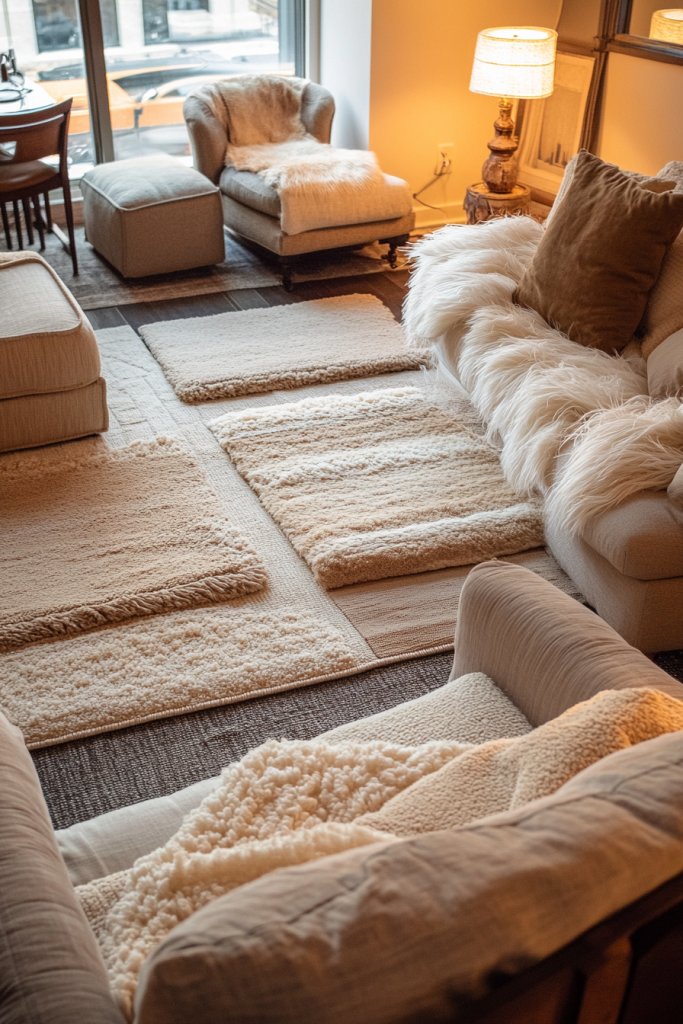
Living in a small apartment often feels like trying to fit a square peg into a round hole. You want your space to feel warm and inviting, but the lack of defined zones makes it seem chaotic and unwelcoming. Layering rugs might sound like a luxury, but it’s a clever trick to add warmth without cluttering your floors. It’s all about creating cozy corners that draw you in.
Imagine walking into a snug corner with a plush, textured rug in a soft cream hue layered over a darker base. The tactile surface invites barefoot strolls, while the different textures add depth and richness. The rugs catch the light differently, highlighting subtle patterns and making the space look layered and intentional. The visual separation between seating areas feels natural and relaxing.
Choose rugs in neutral tones for a calming vibe or go bold with patterns and colors to energize a space. For winter, opt for thicker, shaggy textures that embrace the cold; in summer, lighter, flat-weave options work best. You can also layer smaller accent rugs over larger ones to create a personalized look that suits your style or mood. Seasonal swaps keep things fresh and fun.
Start by measuring your space to determine the size and shape of your rugs. Select plush, textured options made of durable materials like wool or synthetic fibers. Layer a smaller, softer rug over a larger, more practical one to define zones without overwhelming the floor. Use non-slip pads underneath to keep everything in place. Arrange the rugs to form natural conversation areas, ensuring they’re proportionate to your furniture.
Add a pop of color with a bold border or contrasting edge to make your layered rugs stand out. Incorporate complementary textiles like throw blankets or cushions nearby for a cohesive look. Mix textures—think a shaggy rug with a smooth kilim—to add tactile interest. Personal touches like vintage rugs or handmade pieces make your space uniquely yours.
Layered rugs are a simple yet powerful way to transform your small apartment into a cozy sanctuary. They visually break up the space and add tactile comfort, making every step feel indulgent. Plus, they’re versatile enough to adapt as your style evolves. Ready to make your floors a focal point of comfort and style?
2. Incorporate Multi-Functional Furniture for Space Optimization
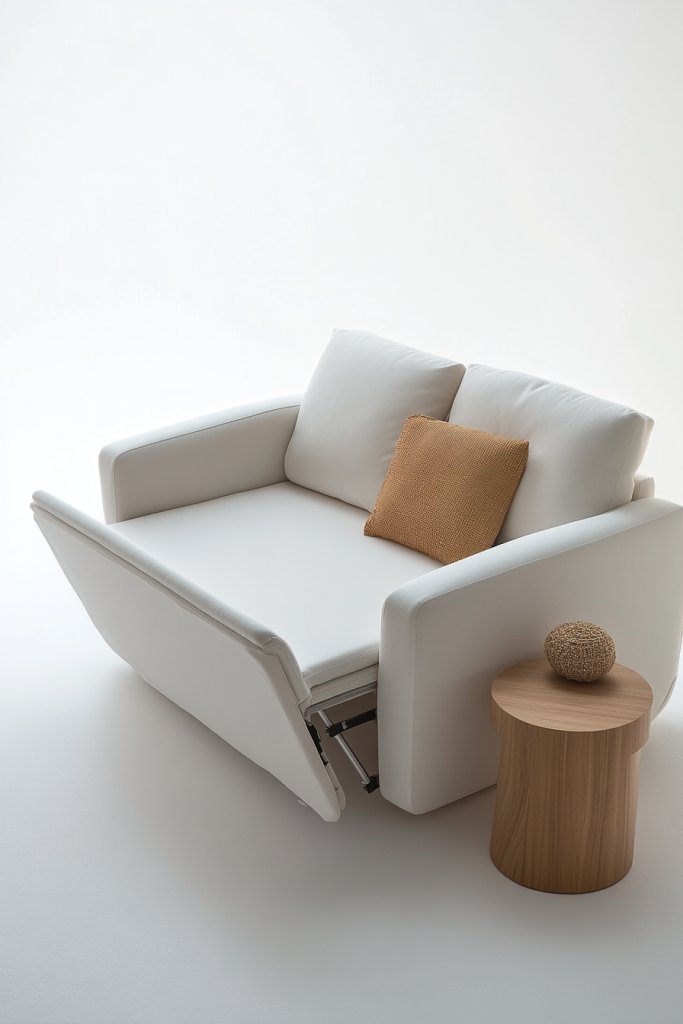
Small apartments often demand clever solutions to maximize every inch. You want furniture that’s practical but doesn’t make your space feel cluttered or cramped. Multi-functional pieces are the secret weapon to get the most out of limited square footage. They turn a simple sofa into a storage unit or a bed into a workspace, making your life easier.
Picture a sleek ottoman that opens up to reveal a hidden storage compartment filled with blankets or magazines. Imagine a sofa that folds out into a bed for unexpected guests, with built-in shelves for your favorite books or accessories. The furniture maintains a minimalist look, yet offers multiple uses. It’s like having an entire room’s worth of solutions in a single piece.
Choose pieces with clean lines for modern aesthetics or vintage-inspired designs for a cozy, eclectic vibe. For small spaces, opt for fold-away or wall-mounted beds and desks to free up floor space during the day. If you have a flexible style, combine different pieces for a layered look that’s both functional and decorative. Adjust your choices seasonally or as your needs change.
Start by assessing your daily routines and storage needs. Look for furniture that includes hidden compartments, fold-out mechanisms, or modular features. Prioritize quality, especially for parts that will see frequent use. Measure your space carefully to ensure the pieces fit comfortably without blocking pathways. Assembly might require some DIY skills, but many options now come with easy instructions. Incorporate decorative textiles or covers to match your decor.
Add personal flair with custom upholstery or colorful cushions. Incorporate small, portable tables or stacking units that can serve as side tables or extra seating. Use decorative hardware or finishes to match your style, from matte black to polished brass. Personal touches like vintage or upcycled furniture pieces can give your space character.
Multi-functional furniture turns limitations into opportunities. It allows you to create a versatile environment that adapts as your lifestyle changes. You’ll feel more organized and less overwhelmed, knowing each piece serves multiple purposes. Time to rethink what furniture can do for you and your cozy space.
3. Add Ambient Lighting with Warm-toned Lamps and Fairy Lights
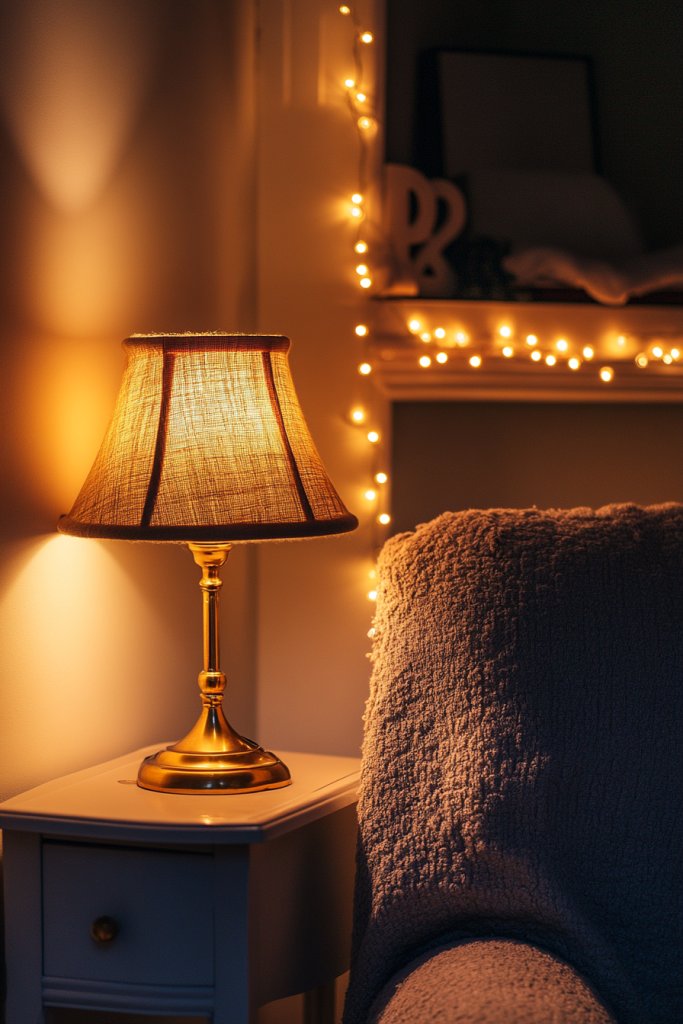
In small apartments, lighting can make or break the vibe. Harsh overhead lights often feel clinical and uninviting, especially when space is tight. You want your home to feel warm and relaxing, but achieving this without cluttering surfaces is tricky. Ambient lighting is the answer, transforming cold spaces into cozy retreats.
Envision a corner softly illuminated by a warm-toned floor lamp with a textured fabric shade. String fairy lights are draped along shelves or across curtains, casting a gentle, twinkling glow. The interplay of different light sources creates layers of warmth and depth. The soft radiance invites you to unwind and stay a little longer, even after the sun sets.
Use dimmable lamps to control brightness and mood. For a minimalist look, choose sleek, modern fixtures in warm metallic tones. In a boho or eclectic space, incorporate vintage lamps with colorful or textured shades. Seasonal adjustments might include replacing fairy lights with candles or lanterns for a cozier vibe. Experiment with placement to highlight architectural features or cozy corners.
Start with a mix of lighting options—floor lamps, table lamps, and fairy lights. Focus on warm white or amber bulbs to create a soothing atmosphere. Avoid overly bright or cold-toned lights that can diminish the cozy feel. Use extension cords or smart plugs for easy control and placement flexibility. Position lights to cast soft pools of light rather than direct beams, and consider using dimmers for ultimate control. Keep cords discreet to avoid visual clutter.
Incorporate decorative lampshades or covers to add texture and color. Use string lights with unique shapes or colors for a playful touch. Add scented candles or reed diffusers nearby to combine visual warmth with inviting aromas. Personalize the space further with handmade or vintage fixtures that tell a story.
Thoughtful ambient lighting elevates your small apartment from dull to delightful. It’s easy to switch the mood from energetic to relaxing with just a change of bulbs or placement. Your space will feel more inviting and personalized, making every evening feel special. Who knew lighting could be such a simple mood booster?
4. Hang Curtains to Create a Sense of Privacy and Soften the Space
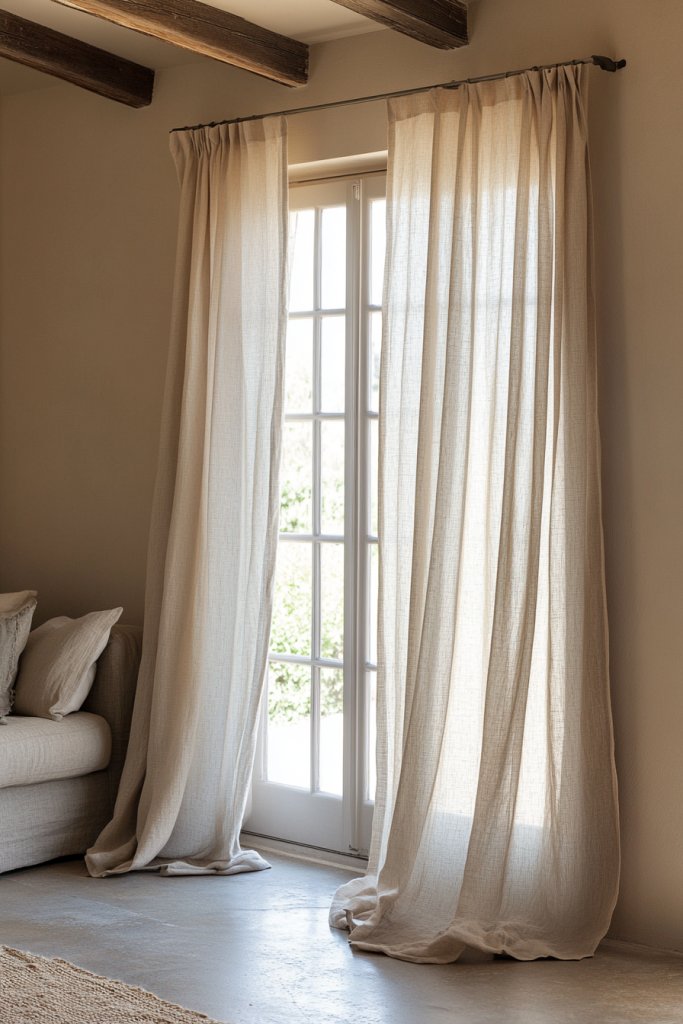
Small apartments often lack privacy, making it hard to create separate zones or hide clutter. You want your living room to feel cozy and private without sacrificing natural light. Hanging curtains offers a quick fix, softening harsh lines and adding a layer of intimacy. It’s a simple trick that transforms open-plan chaos into a serene retreat.
Picture floor-to-ceiling curtains in a light, neutral fabric flowing gently as you walk past. They frame your space, creating a visual barrier that’s both functional and decorative. When drawn, they soften the room’s edges, making it feel more enclosed and cozy. The fabric adds a tactile softness that invites touch and changes the atmosphere instantly.
Opt for sheer curtains for a bright, airy feel or heavier fabrics for more privacy and insulation. Choose natural fibers like linen or cotton for a casual look, or velvets for luxury. You can also layer curtains in different textures or colors to match seasons or moods. Use lightweight rods for a minimal look or decorative hardware for a statement effect.
Measure your windows carefully to select the right length and width. Install sturdy ceiling-mounted or wall-mounted rods to support the fabric’s weight. Use tiebacks or holdbacks to open the curtains during the day, and close them at night for privacy. Select fabrics that complement your decor—think neutral tones for calm or bold patterns for personality. Regularly wash or steam curtains to keep them fresh.
Add decorative tiebacks or beaded curtain tassels for a personalized touch. Incorporate blackout liners if you need better sleep or energy efficiency. Layer curtains with decorative pelmets or valances for extra style. Personalize with fabric choices that reflect your personality, from vintage florals to modern geometrics.
Curtains are one of the easiest ways to add softness and privacy to your small space. They instantly change the room’s feel, making it more inviting and private. With a variety of fabrics and styles, you can customize your cozy retreat exactly how you want it. Who knew a simple fabric could make such a big difference?
5. Use Vertical Shelving for Decor and Storage
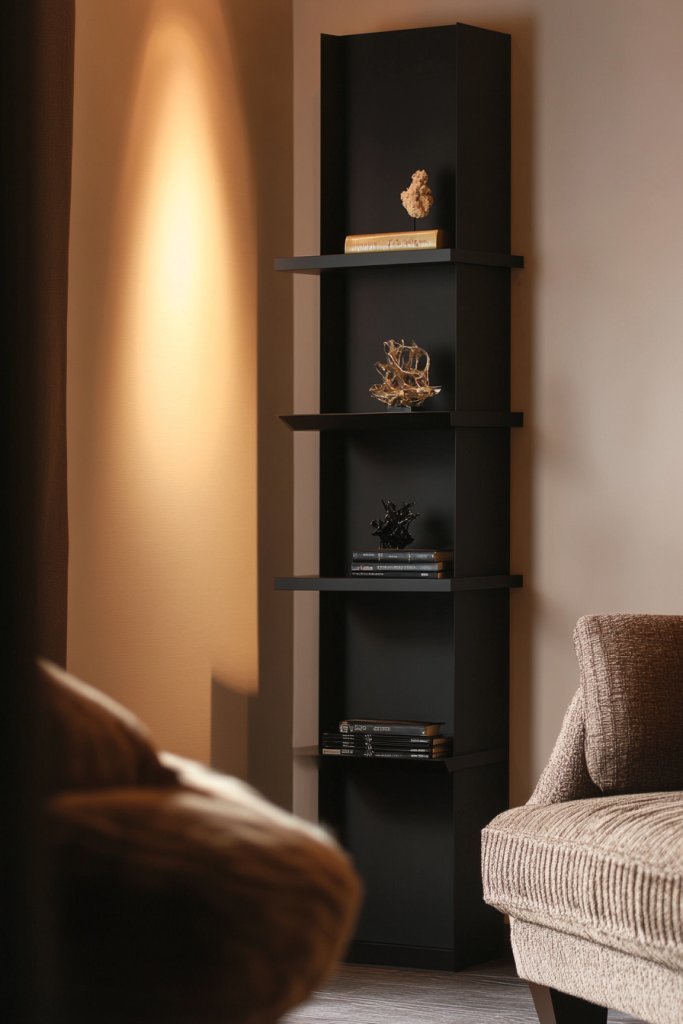
Clutter is the enemy of cozy in small apartments. Limited surface space makes it hard to display your favorite items without making things look chaotic. Vertical shelving offers a clever solution—maximizing wall space for both storage and decoration. It keeps essentials within reach while adding visual interest.
Imagine a tall, open shelving unit reaching from floor to ceiling, filled with neatly organized baskets, books, and decorative objects. The open design creates a sense of height, drawing the eye upward and making the room appear larger. Brightly colored or textured baskets hide clutter, while curated objects add personality. The shelves provide a perfect balance of form and function.
Choose minimalist, industrial, or rustic styles depending on your decor. Mix and match baskets, boxes, and small containers for versatility. Install shelves at different heights to break monotony or emphasize certain areas. Use floating shelves for a sleek look or traditional bookcases for a more classic vibe. Adjust the arrangement seasonally or as your collection grows.
Start by measuring your wall space to determine the number and size of shelves needed. Use sturdy brackets or wall mounts that can support weight, especially if you plan to store heavier items. Use a level to ensure even installation. Decorate with a mix of functional and decorative items, avoiding clutter. Secure shelves properly to prevent accidents, especially in high-traffic areas.
Paint or stain shelves to match your decor for a seamless look. Incorporate decorative ledges or edge trims for added style. Display a curated selection of your favorite books, art pieces, or collectibles. Personalize with small framed photos or unique objects that tell your story.
Vertical shelving turns blank walls into functional art displays. It helps organize your essentials while adding visual appeal. With a little effort, your small space becomes more open and personalized. Ready to elevate your decor and declutter at the same time?
6. Incorporate Comfortable, Compact Seating with Throw Pillows
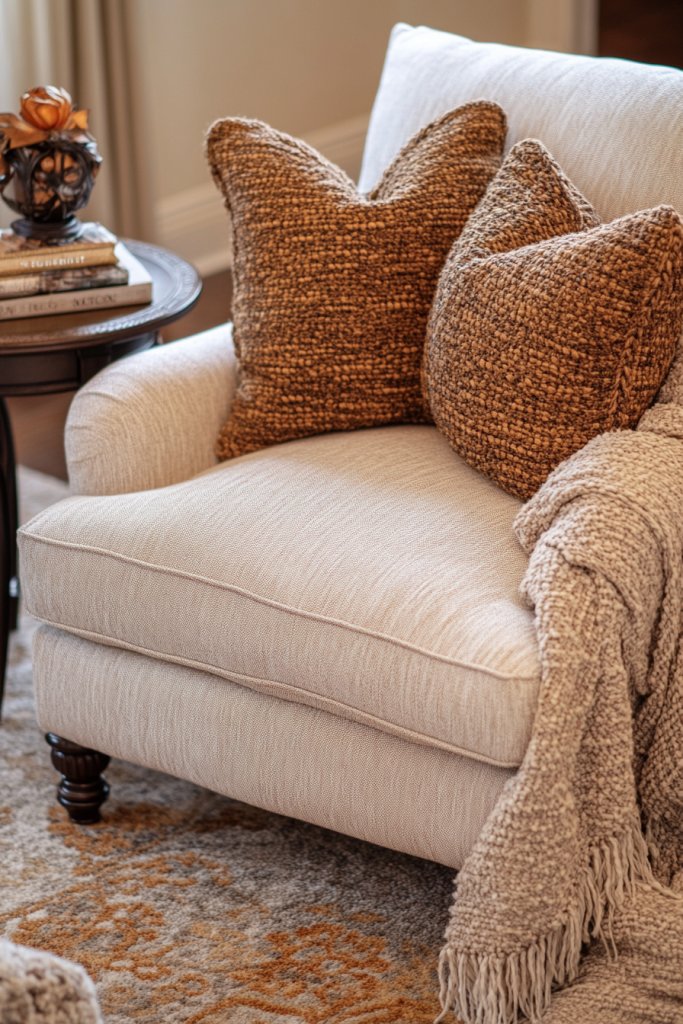
A small apartment often lacks a dedicated lounge area, making it hard to relax or entertain guests comfortably. You want seating that’s cozy without overwhelming your space. Compact, comfortable chairs or loveseats with plenty of throw pillows can turn any corner into an inviting nook. It’s all about creating a place you actually want to spend time in.
Visualize a plush armchair with a soft, oversized cushion and a handful of colorful throw pillows. The textures and patterns add personality, making the space feel warm and lived-in. Nearby, a small pouf or ottoman doubles as footrest or extra seating during gatherings. The combination of comfort and style makes even the smallest room feel welcoming.
Select furniture with slim profiles to maximize floor space. Mix different textures—velvet, linen, or faux fur—to add tactile interest. Use pillows in various sizes and patterns to reflect your personality. Seasonal pillow covers can keep the look fresh or match seasonal decor. For outdoor-friendly spaces, choose weather-resistant cushions.
Start with a compact armchair or loveseat that fits comfortably in your space. Add multiple throw pillows in inviting fabrics and colors—think warm earth tones or cheerful hues. Use washable covers for easy maintenance. Position your seating near a window or a focal point, and keep the arrangement flexible to adapt for guests or relaxation. Use low-profile furniture to avoid blocking pathways.
Create a signature look with custom pillow covers or embroidery. Incorporate a cozy throw blanket to add warmth and texture. Use decorative trays or small side tables nearby for drinks, books, or snacks. Mix vintage and modern pieces to craft a distinctive, eclectic vibe.
Comfortable, well-styled seating makes your apartment feel like a retreat. It encourages lingering and socializing, even in small spaces. With a few thoughtful touches, your nook becomes the go-to spot for relaxation and fun. Who says small can’t be cozy?
7. Create a Focal Point with a Compact Media Console and TV Setup
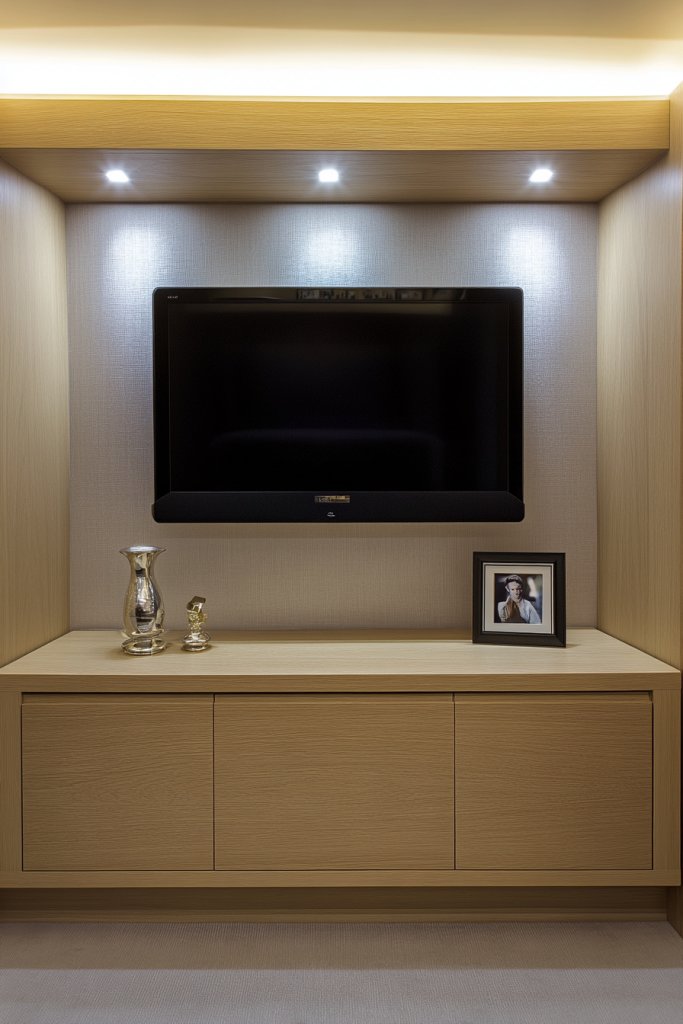
In tiny living rooms, clutter and chaos often steal the show, leaving little room for a true focal point. You want your entertainment setup to be stylish and organized, not an eyesore. A compact media console paired with a sleek TV can anchor your space while maintaining a clean look. It’s the centerpiece that ties everything together.
Picture a slim, modern media unit in a neutral finish, with a wall-mounted TV above it. The console holds essential devices and a few decorative objects, avoiding clutter. Behind it, a textured wall or subtle accent color adds depth without overwhelming. The setup is balanced, functional, and unobtrusive, making your living area feel larger and more intentional.
Choose minimalist designs with hidden storage to reduce visual clutter. For a warmer look, select wood finishes or matte tones. Wall-mounting the TV frees up surface space and creates a sleek appearance. Incorporate floating shelves or small cabinets for additional storage if needed. Adjust height and placement for ergonomic viewing and aesthetic balance.
Start by measuring your space to select appropriately sized furniture. Mount your TV at eye level for comfort. Use cable management systems to hide wires and keep things tidy. Optimize storage with units that include drawers or hidden compartments. Decorate the console with minimal accessories like a small sculpture or a decorative tray, avoiding over-cluttering.
Add a textured or patterned backdrop behind the TV for visual interest. Incorporate personal items such as vintage audio equipment or framed photos elsewhere in the room. Use decorative storage boxes or baskets inside the console for remotes and accessories. Keep the design aligned with your overall decor theme—modern, rustic, or eclectic.
A well-designed media setup anchors your living space and enhances your entertainment experience. It proves that style and function can coexist in small apartments. Upgrading your setup boosts your confidence and makes your space feel more complete. Time to make your entertainment area both sleek and cozy.
8. Add Personal Touches with DIY Textile Wall Hangings or Tapestries
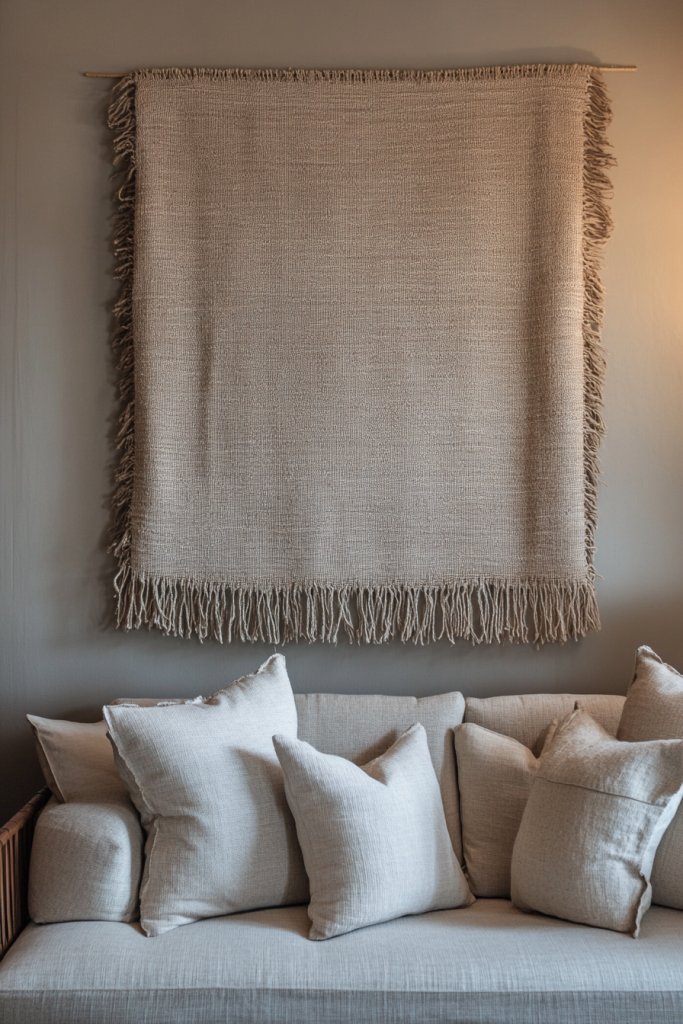
Blank walls in small apartments can feel stark and uninspired, making the entire space seem cold. You crave personality and softness without sacrificing precious space. DIY textile wall hangings or tapestries offer a creative, budget-friendly way to add warmth and character. They turn a plain wall into a visual statement.
Imagine a large, handwoven tapestry in earthy tones draped across a wall, adding texture and color. The fabric’s natural fibers catch the light differently, creating subtle shadows and depth. It offers a cozy, bohemian vibe and invites touch. The layered textiles blend with cushions and throws, creating a harmonious, inviting environment.
Use lightweight fabrics like linen, cotton, or wool for easy hanging. Experiment with different shapes—rectangular, circular, or geometric—to match your decor. Incorporate DIY techniques like macramé, embroidery, or fabric dyeing for a personal touch. Seasonal textiles can be swapped out for variety, keeping the look fresh.
Start by choosing a fabric or textile material that complements your decor. Attach it to a wooden or metal dowel using simple sewing or clips. Hang it on the wall with hooks, nails, or tension rods, depending on wall type. Consider layering multiple hangings for a gallery effect. Keep the size proportionate to your wall to avoid overwhelming the space.
Add embroidery, beadwork, or painted accents for extra detail. Mix different textures and colors to reflect your personality. Incorporate vintage or upcycled textiles for an eco-friendly touch. Personalize with meaningful symbols, quotes, or motifs that resonate with you.
DIY textile wall hangings bring warmth and personality to your space without breaking the bank. They showcase your creativity and make your apartment feel uniquely yours. With a little effort, you can turn a blank wall into a conversation starter. Who knew fabric could be so transformative?
9. Use Mirrors Strategically to Enhance Light and Perception of Space
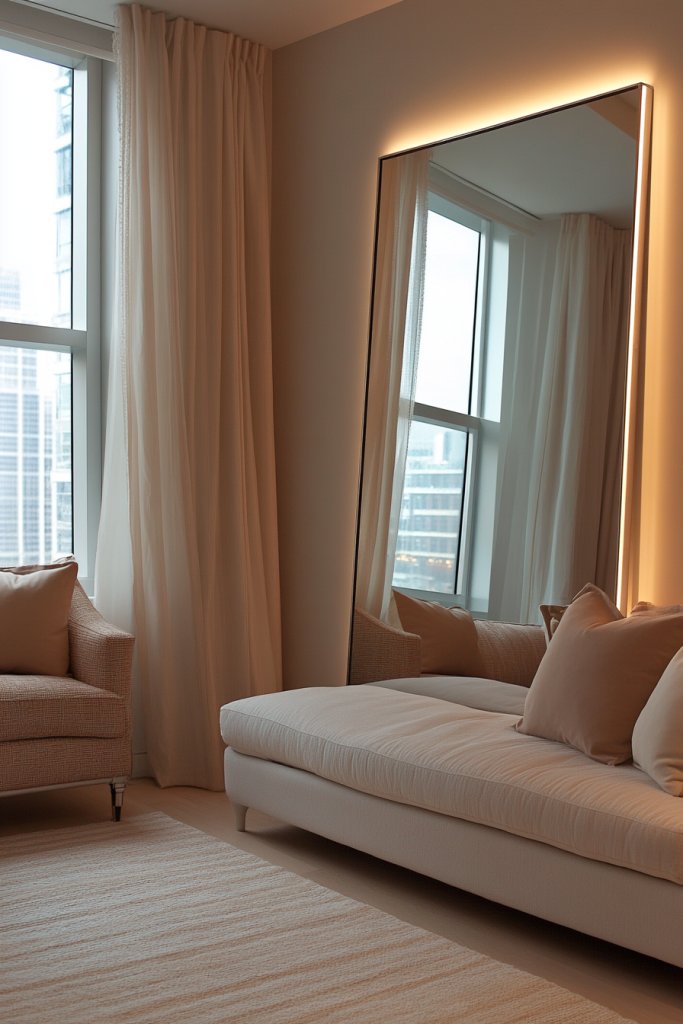
Small apartments often feel dark and cramped, especially if windows are limited. You want to amplify natural light and create the illusion of more space. Mirrors are an affordable and effective way to do both. When positioned well, they bounce light around and make your room seem larger than life.
Imagine a large, frameless mirror leaning against a wall, reflecting a cozy corner filled with textured textiles. The mirror doubles the visual depth, making the room feel open and airy. It captures ambient light from nearby windows or lamps, brightening the entire space. The reflection also adds a layer of visual interest, drawing the eye to different parts of the room.
Opt for full-length mirrors for functional dressing or decorative wall-mounted options with interesting frames. Position mirrors opposite windows or light sources for maximum effect. Use multiple smaller mirrors arranged in a gallery style for a dynamic look. Keep the frames simple or ornate depending on your decor theme—avoid cluttering small walls.
Choose mirrors that complement your style and size constraints. Secure wall-mounted mirrors with appropriate anchors and brackets. Experiment with angles to reflect light into darker corners. Keep the mirrors clean and unobstructed for the best visual impact. Use placement to highlight architectural features or create visual balance.
Decorate mirror frames with paint, washi tape, or embellishments for a custom look. Pair mirrors with artwork or decorative shelving to create a cohesive wall display. Consider using mirrored closet doors to maximize space and reflect your decor. Regularly clean the glass to maintain brightness.
Mirrors are a simple yet powerful tool to open up your small apartment and boost natural light. They help you see your space differently and feel more expansive. Properly placed, they add elegance and brightness effortlessly. Your small space can look big and bright with just a mirror or two.
10. Incorporate Warm, Neutral Color Palettes for Instant Comfort
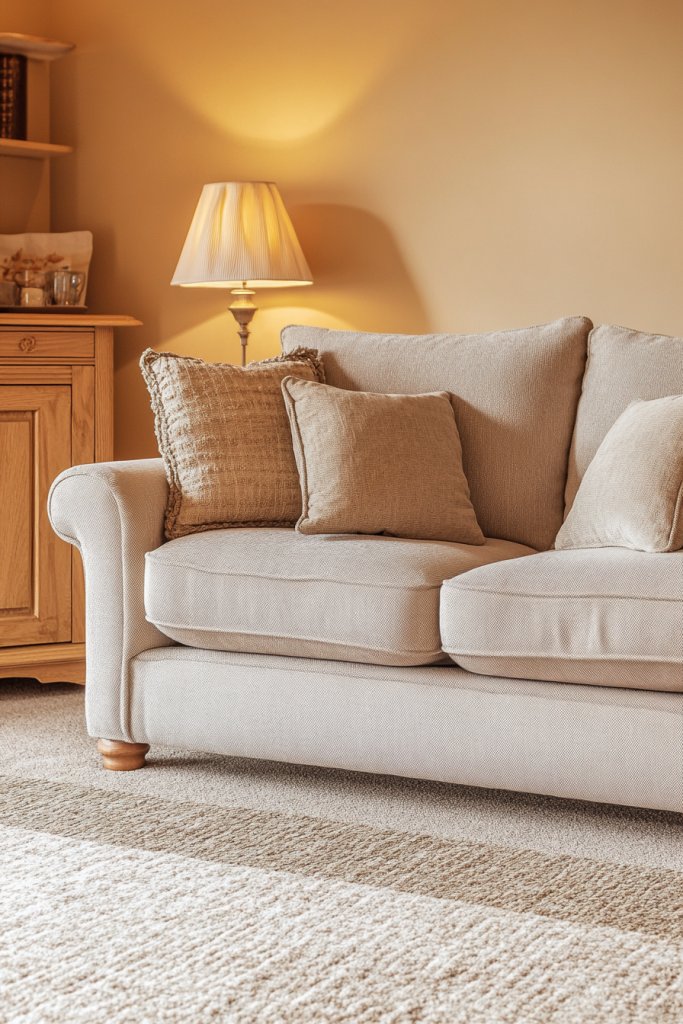
Color can make or break the coziness of your small apartment. Bright, bold hues might energize, but they can also feel overwhelming in limited space. Warm, neutral tones create a calming backdrop that promotes relaxation and makes your space feel more inviting. It’s the foundation for a cozy vibe that lasts.
Picture a living room dominated by soft beige, taupe, and blush accents. The walls are a warm, neutral shade that reflects ambient light gently. Textures like plush cushions, velvet throws, and soft rugs in coordinating tones add depth and comfort. The overall palette creates a seamless, soothing environment that feels effortless and welcoming.
Use different shades within the neutral spectrum to add subtle contrast, such as warm greys or muted browns. Seasonal accents like deep oranges or soft pastels can be added for variety. For a minimalist look, stick to two or three shades; for more personality, layer various textures and tones. These palettes work well with any decor style, from modern to rustic.
Start by painting walls in your chosen warm neutrals, or select furniture and textiles in similar shades. Incorporate different textures—think a velvet cushion or a faux fur throw—to add tactile richness. Keep accessories minimal and cohesive to avoid visual clutter. Use accent pieces in slightly darker or lighter shades to create depth.
Personalize with textured textiles, decorative stitching, or embroidered details. Add metallic or wooden accents for warmth and contrast. Incorporate artwork, but keep the color scheme consistent with your palette. Layering different shades and textures enhances comfort and visual harmony.
A warm, neutral palette creates a calming oasis amid the chaos. It makes small spaces appear larger and more serene. With this foundation, you can easily change accents and textures to keep your environment fresh. Your cozy haven is just a palette away.
11. Maximize Small Spaces with Corner Nooks for Reading or Relaxing
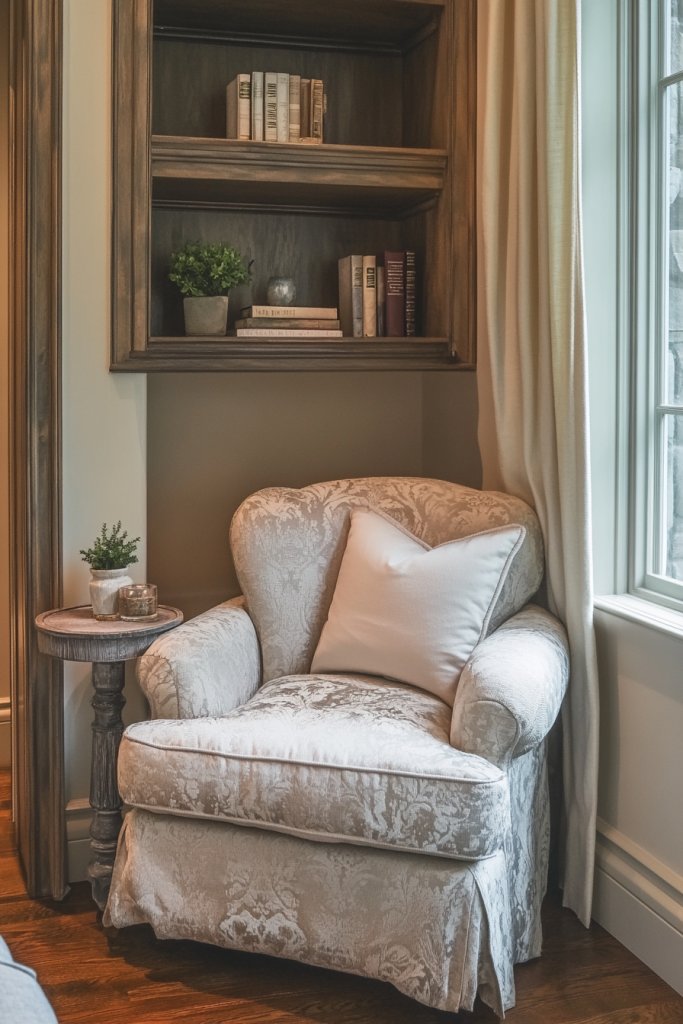
Corners in small apartments often go unused or feel neglected, yet they hold massive potential. You want a dedicated space to unwind, read, or meditate without sacrificing floor space. Creating a cozy corner nook transforms an overlooked spot into your retreat within the room. It’s a simple way to add functionality and comfort.
Visualize a small armchair nestled into a corner, topped with a chunky knit blanket and a side table holding a cup of tea. A soft rug anchors the space, inviting you to settle in. Subtle lighting from a wall-mounted sconce or a small lamp enhances the intimacy. The nook becomes a retreat that visually anchors the room while adding a personal touch.
Use compact furniture suited to your style—think a sleek armchair, a pouf, or a small bench. Incorporate layered textiles like throws and cushions for comfort. Adjust the layout based on your needs: a reading nook, meditation space, or creative corner. Seasonal touches like cozy blankets or decorative pillows keep it inviting year-round.
Identify a quiet corner with good natural light or potential for additional lighting. Choose furniture that fits comfortably without crowding the space. Add a small side table for books or drinks. Use lighting such as sconces or clip-on lamps to save space and create ambiance. Keep the area clutter-free with baskets or storage ottomans nearby.
Personalize with favorite books, decorative objects, or art on the wall nearby. Incorporate a small plant or a scented candle (avoiding restricted content, opt for faux or decorative holders). Use textiles with your favorite patterns or colors to reflect your personality. Change accessories seasonally to refresh the vibe.
A dedicated corner nook makes your apartment more functional and cozy. It’s your personal retreat that encourages relaxation and mindfulness. With minimal effort, you create a space that feels private and inviting. Your small apartment just got a whole lot more livable.
12. Introduce Textured Fabrics and Blankets for Visual and Tactile Warmth
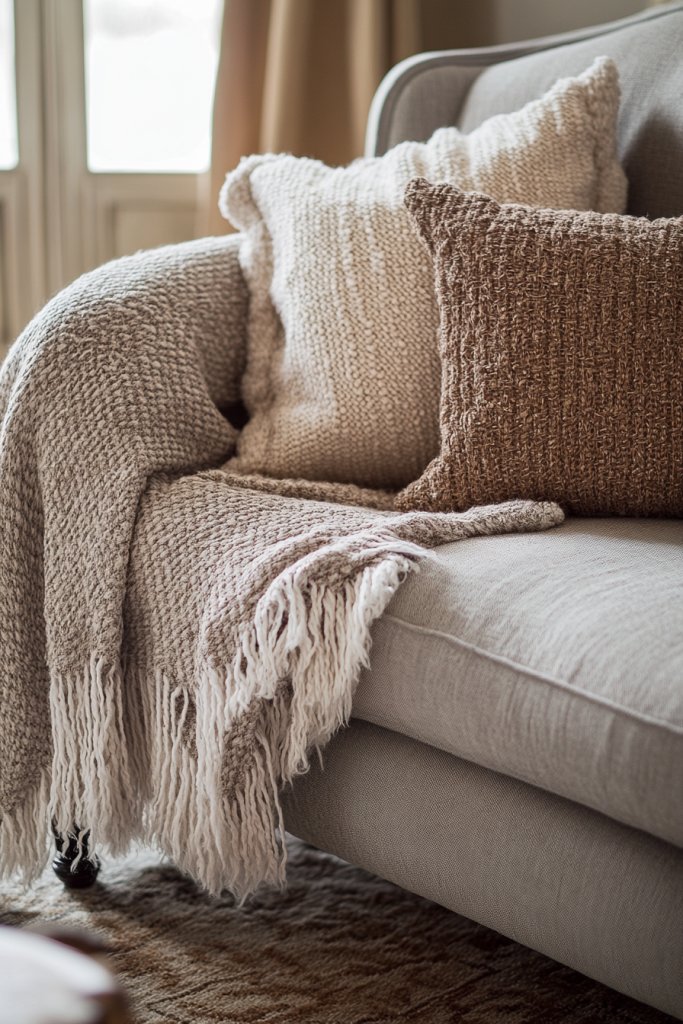
In small spaces, every detail counts—especially when it comes to comfort. Flat, smooth surfaces can feel sterile and uninspiring. Textured fabrics and blankets add depth and warmth, making your living space feel welcoming and cozy. They turn ordinary furniture into statement pieces that invite touch.
Imagine a plush velvet cushion paired with a chunky-knit throw blanket draped over a sofa. The tactile textures catch the light differently, creating subtle shadows and highlights. Soft fabrics in rich, inviting colors evoke a sense of warmth and comfort. The layered textures add visual richness and make your space feel layered and intentional.
Mix textures like faux fur, velvet, chenille, or knits to create a tactile landscape. Use a variety of pillow sizes and shapes to add visual interest. Swap out blankets seasonally—think a lightweight cotton throw for summer and a thick faux fur for winter. Coordinate your textiles with your overall color palette for a cohesive look.
Select high-quality fabrics that feel good and are durable enough for daily use. Add throws and cushions to sofas, beds, or window seats. Use contrasting textures to prevent monotony—pair a smooth linen cushion with a shaggy pillow. Regularly wash or fluff textiles to maintain their softness. Incorporate decorative elements like tassels or embroidery to personalize.
Create a signature look with textiles that reflect your personality—think vintage quilts or modern geometric patterns. Mix and match textures to suit your mood or season. Add decorative trims or fringes for extra detail. Use textiles as a way to introduce accent colors or patterns without overwhelming the space.
Textured fabrics and blankets instantly make your apartment feel warm and welcoming. They encourage lounging and snuggling, turning your space into a true retreat. With a few well-chosen pieces, you can effortlessly upgrade your decor and comfort. Who knew textiles could be so transformative?
13. Use Open and Minimalist Storage Solutions to Reduce Clutter
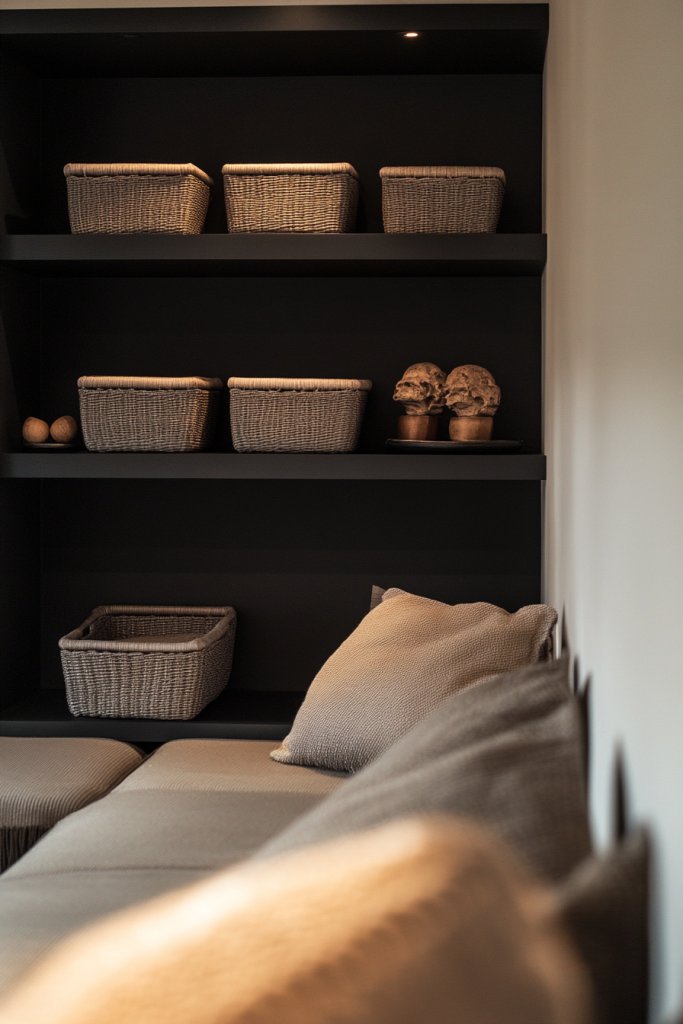
Clutter is the enemy of cozy, especially in small apartments where every inch counts. You need storage solutions that are both functional and visually unobtrusive. Open shelving, baskets, and sleek cabinets keep essentials accessible without creating visual chaos. The goal is a tidy space that feels calm and inviting.
Imagine a wall with open floating shelves holding only a few carefully curated objects—books, baskets, or decorative boxes. The open design keeps clutter at bay while making everything easily reachable. The clean lines and simple design lend a modern, airy vibe. It’s a smart mix of form and function that keeps your space looking fresh.
Choose minimalist, open storage for a sleek look or incorporate woven baskets for warmth and texture. Use clear containers or labeled boxes for easy organization. Floating shelves can be staggered at different heights for visual interest. Incorporate hidden compartments or pull-out drawers in larger units for versatility. Adjust your storage style seasonally or as needed.
Start by measuring your available wall space and selecting open shelving units or baskets that fit. Mount shelves securely to handle daily use, and organize items in a way that’s easy to maintain. Use labels or color coding for quick identification. Keep surfaces clear of unnecessary items, and rotate stored items seasonally for freshness. Regular tidying helps maintain the clean aesthetic.
Personalize with custom-painted or decorated storage bins. Incorporate decorative hardware or labels to add charm. Use woven or textured baskets to add warmth. Combine open storage with some closed cabinets for a balanced look that keeps clutter out of sight when needed.
Open and minimalist storage solutions keep your small apartment looking spacious and organized. They make everyday routines smoother and your space more peaceful. With a little effort, clutter becomes a thing of the past, leaving only your favorite essentials and decor on display. Your cozy, clutter-free oasis awaits.
14. Incorporate Small Indoor Plants in Non-Obtrusive Planters
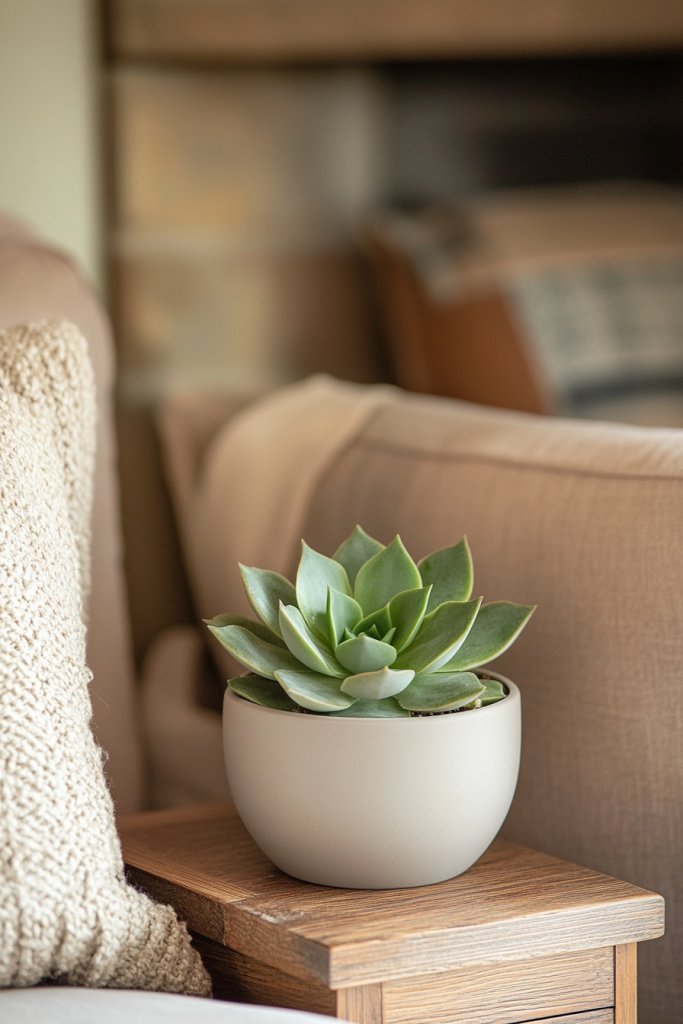
Small apartments often lack the lush greenery that makes spaces feel fresh and alive. But with limited space, adding real plants can seem tricky or overwhelming. The key is choosing low-maintenance, space-efficient plants in stylish, unobtrusive planters. They bring a touch of nature without clutter.
Picture tiny succulents in sleek ceramic pots on a floating shelf or a corner windowsill. The greenery adds a pop of color and texture, softening hard surfaces. Their simple, unobtrusive design keeps the look clean, while the plants’ natural shapes create a calming vibe. It’s a subtle way to bring life into your space.
Opt for compact, low-maintenance plants like succulents, air plants, or small ferns. Use modern, minimalist planters in neutral or metallic tones for a sleek look. Seasonal arrangements or small herb gardens can add variety. Style plants at different heights—on shelves, tables, or hanging planters—to create visual interest.
Choose plants suited for low light or dry conditions to minimize care. Select stylish planters that blend with your decor—think ceramic, concrete, or geometric designs. Place them strategically in corners or on surfaces to maximize space. Water sparingly and use self-watering pots if you’re forgetful. Clean dust off leaves regularly for healthy growth.
Create a mini indoor garden with a themed collection—succulents, cacti, or herbs. Incorporate decorative stones or sand for added texture. Personalize with painted pots or customized labels. Use plants as a natural partition or accent to define zones.
Adding small indoor plants boosts your mood and purifies the air, making your tiny apartment more inviting. They’re easy to care for and endlessly customizable. With just a few stylish pots, you create a lively, fresh environment that feels both cozy and vibrant. Nature’s touch in a small space? Yes, please.
15. Arrange Furniture to Encourage Conversation and Coziness
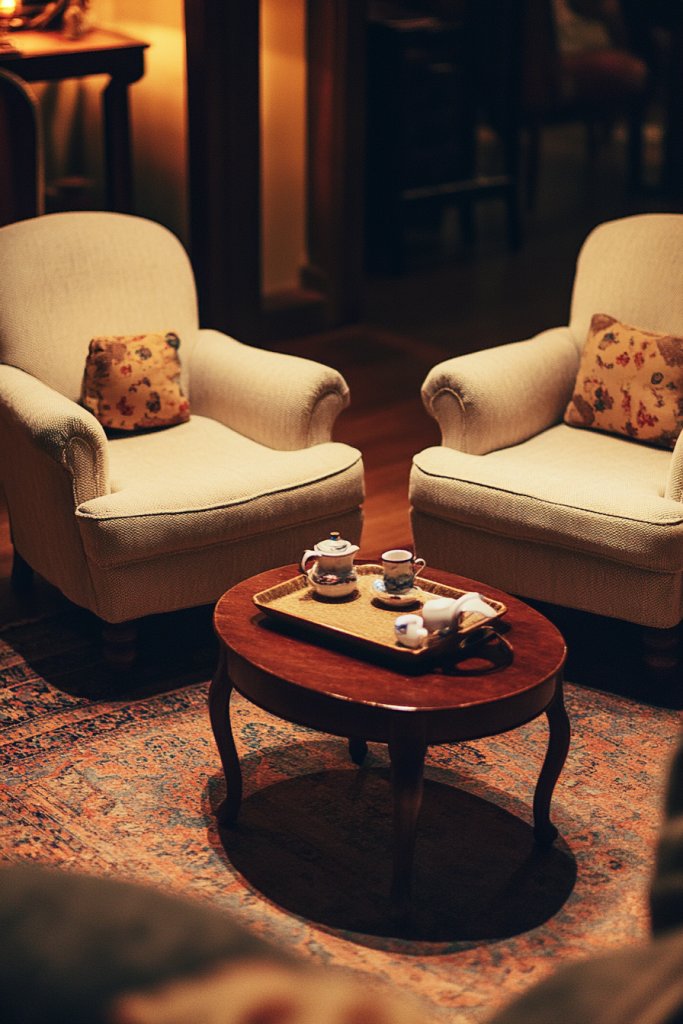
In tight spaces, furniture placement can make or break the social vibe. You want your living area to feel inviting and conducive to conversation, not scattered and awkward. Thoughtful furniture arrangement fosters intimacy and makes the space more functional. It’s all about creating cozy corners where everyone feels comfortable.
Picture a small sofa facing a pair of armchairs with a low, round table in between. The setup encourages eye contact and easy conversation. The furniture is arranged to define a central gathering spot, while leaving enough space to move around comfortably. Soft lighting and textured textiles complete the inviting environment.
Use modular or flexible seating that can be rearranged for different occasions. Incorporate ottomans or poufs that double as seats or footrests. Create multiple conversation zones if space allows, or focus on one main area. Balance the furniture in proportion to the room size—avoid overcrowding or empty corners.
Start by positioning your main seating piece centrally, then arrange secondary pieces to face or face towards it. Leave enough space for walking paths—about 18-24 inches. Use area rugs to anchor the seating zone visually. Add side tables or small storage units nearby for convenience, but keep clutter out of sight.
Incorporate cushions and throws to invite comfort. Use furniture in styles and colors that complement your decor—think warm woods, soft fabrics, or vibrant accents. Decorate with small, personal objects like books or candles within reach. Keep the layout flexible to adapt for guests or different activities.
A well-arranged space encourages social interaction and makes your apartment feel more welcoming. It’s about creating pockets of intimacy that invite lingering. With a little planning, your small living room becomes a social hub that feels both cozy and functional.
16. Use Soft, Ambient Sounds and Scented Candles to Enhance Mood
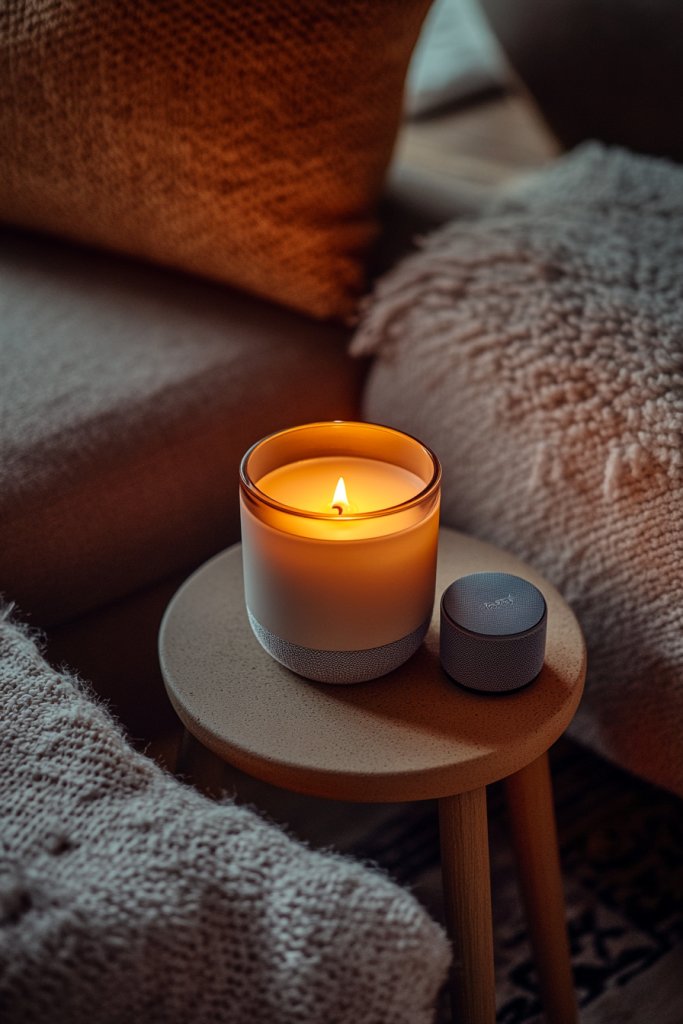
Small apartments can sometimes feel too quiet or overly noisy, making it hard to relax fully. You want an environment that promotes calm and comfort—without adding clutter or distractions. Ambient sounds and subtle scents can transform your space into a sensory sanctuary, setting the mood for unwinding.
Imagine gentle instrumental music playing softly in the background while a faint aroma of vanilla or lavender wafts through the air. The combination of sound and scent creates a relaxing atmosphere that encourages you to breathe deeply and let go of stress. The space feels more alive and inviting, even without visual clutter.
Choose ambient sound options like nature soundscapes, white noise, or chill playlists. Use essential oil diffusers or scented wax melts in unobtrusive holders—preferably ceramic or metal for a sleek look. Rotate scents seasonally or according to your mood. Keep sound sources discreet—think hidden speakers or small portable devices.
Set up a small speaker or sound system that connects via Bluetooth for easy control. Choose calming playlists or nature sounds that loop seamlessly. Place diffusers or scented candles in areas with good airflow—away from curtains or flammable objects. Use timers or smart devices to automate scent release and music playback. Adjust volume and scent intensity for maximum effect.
Select your favorite calming scents—think chamomile, sandalwood, or citrus—and experiment with blends. Incorporate decorative holders that match your decor style, from minimalist ceramic to vintage brass. Personalize with your preferred sounds—nature, jazz, or ambient music. These elements turn your home into a sensory retreat.
Adding sensory elements elevates your small apartment into a relaxing haven. They help you unwind after a busy day and create a cozy ambiance effortlessly. With minimal effort, you craft an environment that nurtures your mood and well-being. Who knew sound and scent could make such a difference?
17. Incorporate Compact, Stylish Storage Ottomans for Dual Functionality
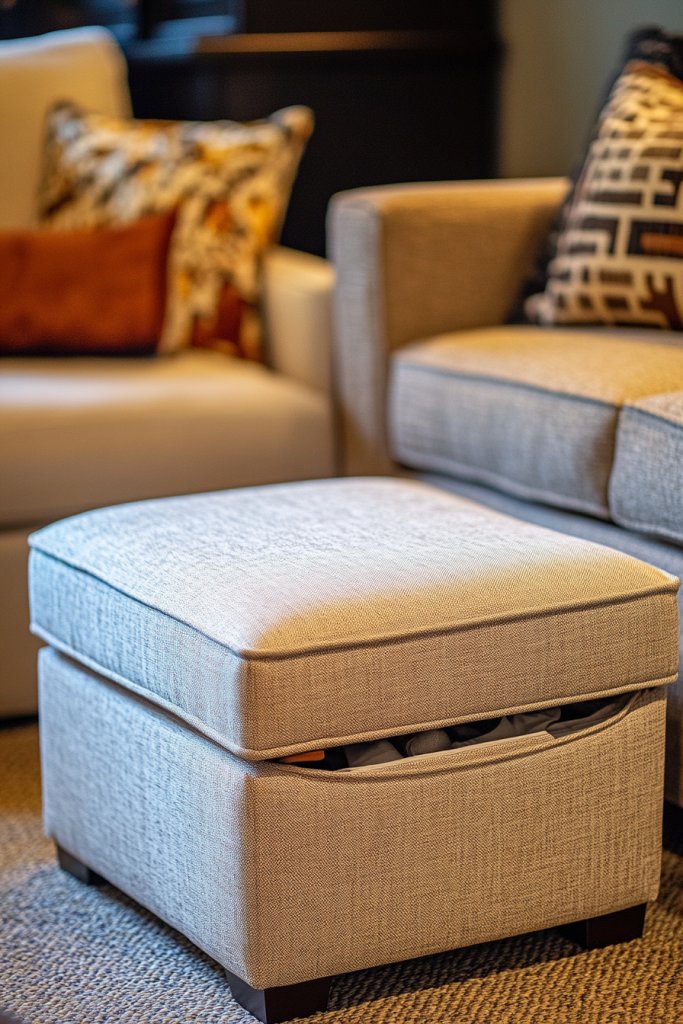
In tiny apartments, finding space for everything is a constant challenge. You need furniture that offers storage without sacrificing style or comfort. Storage ottomans are the perfect solution—serving as footrests, extra seating, and hidden storage all in one. They keep clutter out of sight while adding a touch of chic.
Visualize a sleek, tufted ottoman in a neutral fabric placed in front of your sofa. It opens to reveal a cavernous space for blankets, magazines, or small accessories. The textured upholstery adds softness and elegance, blending seamlessly with your decor. It’s both functional and attractive, transforming your living area into a clutter-free zone.
Choose ottomans in fabrics and colors that complement your existing decor—think velvet, faux leather, or woven textiles. Use them as coffee tables by adding a tray on top, or as casual seating during gatherings. For a more playful vibe, opt for patterned or colorful options. They adapt well to seasonal updates or changes in decor.
Select a size that fits your space and storage needs—measure your available area first. Look for sturdy construction with easy-to-open lids. Place the ottoman where it’s accessible but doesn’t block pathways. Use it to store items you want close at hand but out of view. Consider adding decorative pillows or throws to make it more inviting.
Personalize with embroidered initials or decorative trims. Use it as a base for a cluster of smaller accessories like candles or books—keeping the top surface functional. Mix different textures and colors for visual interest. Replace or update covers seasonally for a fresh look.
A stylish storage ottoman maximizes utility while elevating your decor. It reduces clutter and adds a cozy, inviting feel. Perfect for small spaces, it proves that practicality and style can go hand in hand. Time to sit back and enjoy your clutter-free zone.
18. Install Floating Shelves for Decorative and Practical Items
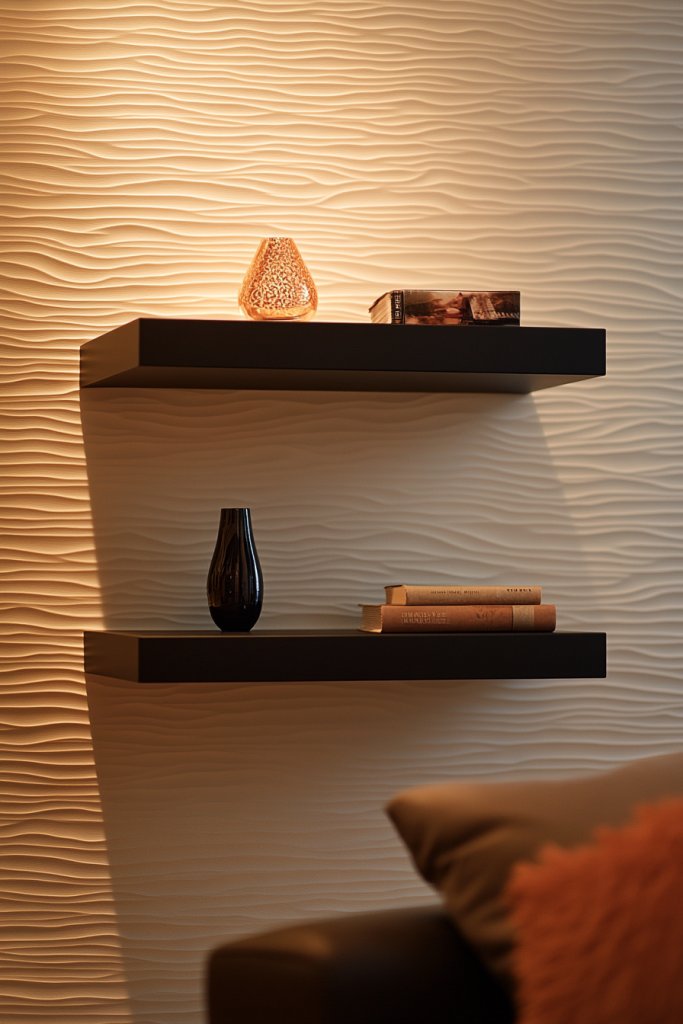
Wall space in small apartments often feels underutilized or cluttered. You want a sleek way to display your favorite items and keep essentials organized without sacrificing floor space. Floating shelves are the perfect trick—combining form and function in a minimal, stylish package.
Picture a set of narrow, wooden floating shelves arranged in a staggered pattern on a blank wall. They hold a curated collection of books, decorative boxes, or small keepsakes. The floating design adds a sense of lightness and modernity, making the room feel more open. The shelves draw the eye upward, emphasizing height and space.
Choose materials and finishes that match your decor—think matte black metal, light wood, or glossy lacquer. Mix different lengths and depths for visual interest. Use the shelves to display a combination of practical items and decorative objects, but avoid overcrowding. Change the arrangement seasonally or for special occasions.
Start by measuring your wall area and selecting appropriate shelf sizes. Use secure brackets and anchors suitable for your wall type—drywall, brick, or plaster. Install at heights that suit your eye level and furniture layout. Decorate with a balance of items that reflect your personality, keeping clutter minimal. Regularly dust and rearrange to keep things fresh.
Paint or stain shelves to match your decor palette. Incorporate decorative brackets or trim for a finished look. Use baskets or small containers on the shelves for tiny accessories or cords. Personalize with themed collections or seasonal decor, making the display a reflection of you.
Floating shelves make your walls work for you, transforming blank space into a mini gallery. They help organize essentials while adding visual appeal. With minimal effort, you create a stylish, functional focal point. Your small apartment just became a lot more creative.
19. Select Compact, Modern Coffee Tables with Hidden Storage
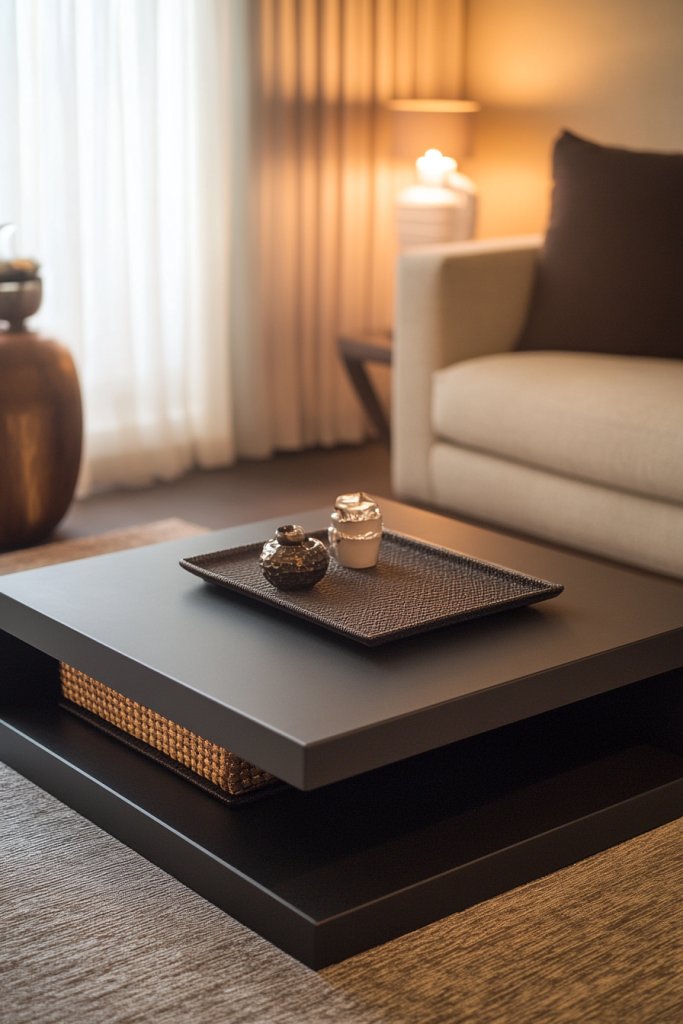
A cluttered coffee table can ruin the cozy vibe in a small apartment’s living room. You need a sleek, modern piece that offers storage without taking up precious space. Compact coffee tables with hidden compartments keep your essentials close while maintaining a clean, uncluttered look. They’re both practical and stylish.
Imagine a streamlined, rectangular coffee table with a lift-top lid revealing storage for magazines, remotes, or snacks. Its smooth surface is perfect for drinks or decorative trays, keeping the space looking tidy. The minimalist design blends seamlessly with your decor, adding a contemporary touch while hiding clutter underneath.
Choose tables with clean lines and neutral finishes like black, white, or wood grain. Opt for multi-functional designs—such as nesting tables or those with drawers. Match your decor style—modern, mid-century, or industrial—by selecting appropriate materials. Adjust size based on your room’s scale, ensuring it doesn’t overpower the space.
Measure your available space to select the right size and shape. Look for sturdy construction with a smooth hinge or lift mechanism. Keep the top surface free of clutter by regularly reorganizing stored items. Use decorative trays or coasters on the surface to protect finishes. Consider mobility options like small casters if you need flexibility.
Add decorative elements like a small plant, candles, or a stack of favorite books atop the table (avoiding restricted items). Customize with removable or washable covers for the storage compartments. Incorporate accent colors or patterns through accessories that sit on or inside the table. Make it a centerpiece that reflects your style.
A sleek coffee table with hidden storage keeps your space organized without sacrificing style. It elevates your entire living room while hiding everyday clutter. With a modern, functional piece, your small apartment looks polished and inviting. Ready to upgrade your central hub?
20. Personalize the Space with Handmade or Upcycled Decor Items
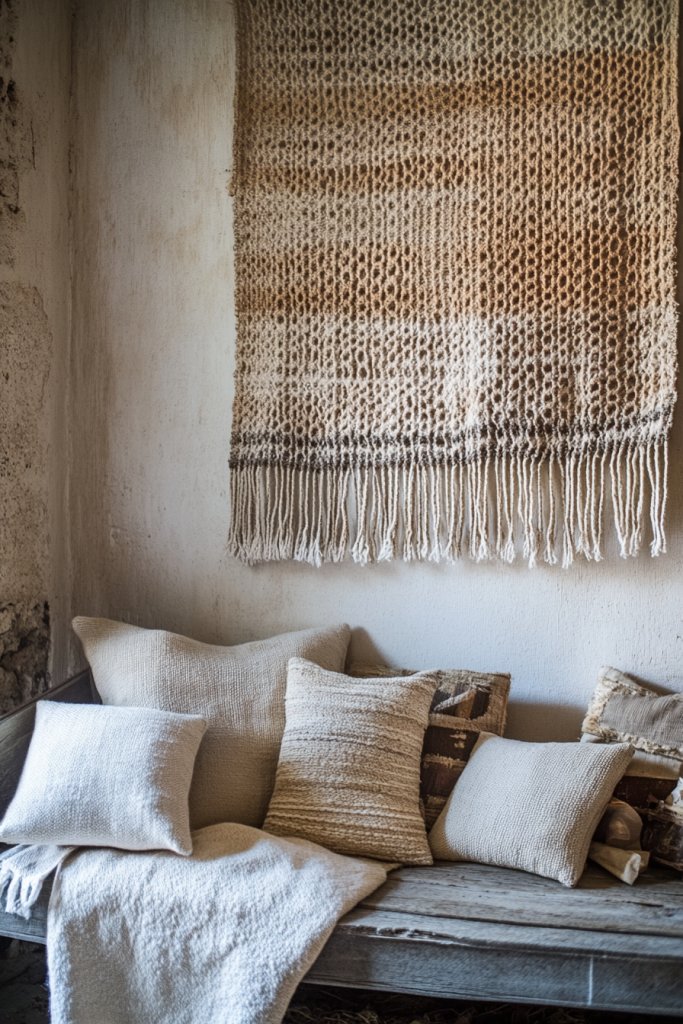
Your small apartment can feel generic or impersonal, lacking that special touch that makes it truly yours. You want decor that reflects your personality without breaking the bank. Handmade or upcycled items offer unique, meaningful accents that add warmth and character. It’s a chance to turn everyday objects into art.
Visualize a wall adorned with a framed piece of upcycled wood art, or a shelf decorated with vintage jars repurposed as storage containers. Handcrafted wall hangings or painted furniture pieces add personality and charm. The imperfect, personal touches create a cozy, lived-in vibe that’s distinctly yours. It’s all about storytelling through decor.
Use DIY projects like painting, decoupage, or sewing to customize furniture and accessories. Incorporate recycled materials—think wine crates turned shelves or fabric scraps into cushions. Match upcycled items with your decor style—rustic, boho, or industrial—for a cohesive look. Change or update your handmade pieces seasonally for freshness.
Start with accessible DIY tutorials or thrift shopping for vintage or reclaimed items. Repurpose furniture or decor with simple techniques—painting, staining, or embellishing. Securely attach or display your creations, ensuring they’re stable and safe. Mix and match different upcycled pieces to build a layered, personal environment. Regularly refresh your decor to keep it interesting.
Add personal touches like hand-stitched cushions, painted art, or customized wall hangings. Use natural or eco-friendly paints and finishes to add an organic feel. Incorporate meaningful memorabilia or handmade crafts that tell your story. Keep your decor evolving to reflect your changing tastes and experiences.
Handmade and upcycled decor makes your apartment uniquely yours, full of stories and personality. It’s a sustainable choice that adds warmth and authenticity. Creating your own pieces boosts confidence and makes your space feel truly special. Your cozy, personalized oasis is just a craft project away.
Conclusion
Exploring these diverse small apartment living room ideas shows that comfort and style go hand in hand, no matter the size of your space. Don’t hesitate to try out different layouts, decor accents, and organizational hacks—your perfect cozy corner is just a step away. Embrace these ideas and transform your living room into a charming retreat you’ll love coming home to!